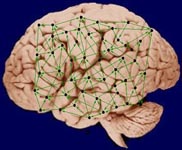Scientists identify brain network related to intelligence

Washington, September 12 : Researchers at two universities in the US say that they have identified a brain network related to intelligence.
Richard Haier of the University of California, Irvine and Rex Jung of the University of New Mexico say that the brain network identified by them primarily involves areas in the frontal and the parietal lobes.
The researchers call their theory for the neural basis of intelligence 'Parieto-Frontal Integration Theory' (P-FIT). Reported in the online edition of the journal Behaviour and Brain Sciences, it includes peer commentary from 19 researchers.
"Recent neuroscience studies suggest that intelligence is related to how well information travels throughout the brain," said Haier, a professor of psychology in the School of Medicine and longtime human intelligence researcher.
"Our review of imaging studies identifies the stations along the routes intelligent information processing takes. Once we know where the stations are, we can study how they relate to intelligence," he added.
The researchers have based their theory on a review of 37 imaging studies, which suggests that some of the brain areas related to intelligence are the same areas that are related to attention and memory, and to more complex functions like language.
Haier and Jung say that this possible integration of cognitive functions suggests that intelligence levels may be based on how efficient the frontal-parietal networks process information.
Although there is still discussion about how to define and measure intelligence, Haier and Jung found surprising consistency in the studies they reviewed despite the fact the studies represented a variety of approaches.
"The Jung & Haier P-FIT model shows how far we have progressed toward understanding the biological basis of intelligence. Twenty-five years ago researchers in the field were engaged in an unedifying discussion of the relation between skull sizes and intelligence test scores," University of Washington psychologist Earl Hunt writes in his peer commentary.
"By taking advantage of the huge advances in measurement of the brain that have occurred in the past quarter century, (Jung and Haier) can take the far more sophisticated view that individual differences in intelligence depend, in part, upon individual differences in specific areas of the brain and in the connections between them," he adds.
In a 2004 study, Jung and Haier found that regions related to general intelligence are located throughout the brain, and that a single "intelligence centre", such as the frontal lobe, was unlikely.
In a 2005 study, they found that while there are essentially no disparities in general intelligence between the sexes, women have more white matter and men more gray matter related to intelligence test scores. The finding suggested that no single neuroanatomical structure determined general intelligence, and that different types of brain designs could produce equivalent intellectual performance.
"Genetic research has demonstrated that intelligence levels can be inherited, and since genes work through biology, there must be a biological basis for intelligence. We have a long way to go before we understand the details, but our P-FIT model provides a framework for testing new hypotheses in future experiments," Haier said.(With Inputs from ANI)